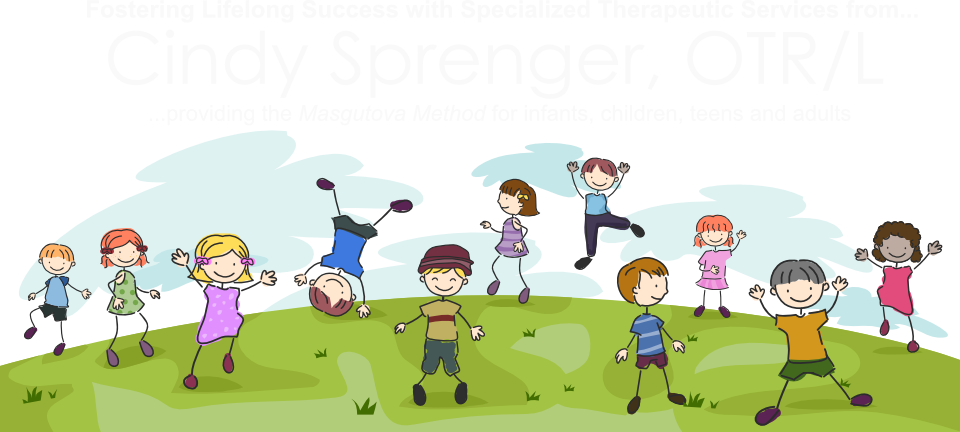What to expect…
It’s difficult to describe a typical session because it varies so much with each individual based on the persons’ age, abilities and challenges. Below I’ll try to give you some idea of what a typical session might “look” like depending on the person.
Being an experienced Occupational Therapist who has whole-heartedly embraced the Masgutova Method, I’ve adopted an eclectic approach to providing therapy for my clients. Though I utilize the Masgutova Method as my primary treatment modality most of the time, I continually incorporate other knowledge I’ve acquired from years of clinical experience and training. When I feel it’s beneficial and the best use of our time, I may incorporate other modalities and methodologies into our sessions.
Some of these specialized techniques include:
• Interactive Metronome®
• Therapeutic Listening®
• Handwriting Without Tears®
• Sensory Integration methods
• Beckman Oral Motor techniques
• Fine Motor & Visual Motor skill development
• DIR®/Floortime™ Affect-Based Language Curriculum (ABLC)
• S.A.N.E. Approach: Sleep, Activities, Nutrition, Environment
Infants & Children
I’m very experienced at working with high energy and challenging kids, including those with sensory processing difficulties and children at all levels of the autistic spectrum. I have the goal of trying to treat most of my patients on a treatment table. The table provides a natural boundary for “squirmy” or “squirrely” kids. When first starting treatment, some kids can barely remain on the table for more than few minutes at a time. Then they need to go off the table for a “reinforcement activity”. I also utilize floor mats when it’s more appropriate. This cycle my be repeated several times for the entire duration of the session. As positive changes from the therapy take hold, children usually need less time off the table.
In some instances, I’ve utilized a PECS™-style work station approach with the goal of “first we exercise” then we go do a specific activity or play with a particular toy at a station that I’ve previously setup in the room. When all else fails, sometimes my clinical decision making process leads me to following the child around the room and administering their exercises “on the go“.
With other children, most of the session will be spent on the treatment table. This helps me to easily move from one side of their body to the other or from their head to their feet. The “exercises” may either be active or passive in nature. This depends on the specific reflex, type of exercise, developmental level of the child and stage of reflex development and integration.
Should parents stay with their child or leave the room during a treatment session? This question really depends on each individual child. I always like to have the parents attend some of our sessions at least part of the time. It allows me to teach them or update a home exercise program and keep abreast of their child’s progress. However, sometimes kids can be uncooperative when mom or dad is present. In those cases, I usually ask the parent(s) to leave the room for the majority of the session. This usually helps make the session much more productive, at least initially. As positive changes occur and behaviors improve, parents are certainly welcome to join us to observe and learn. Sometimes parents are absolutely priceless in their ability to help engage and entertain their child as I go through the exercises. And other times parents just need to take a break! They may want to go into our lobby to read, take a walk or sit outside to relax if the weather is nice or run a quick errand at the shopping centers near University Parkway & I-75 or the stores in the Lakewood Ranch Market Square and Town Center.
Teens & Adults
For most teens and adults, my treatment sessions are quiet and relaxing. I like to keep the fluorescent lights off and have soft natural light streaming into the room. I ask you to remove your shoes for our session and otherwise you remain fully dressed. It is best to wear loose fitting clothes if possible. Women should avoid wearing skirts and dresses if possible. Most of the “exercises” are usually accomplished with you either laying or sitting on my treatment table. Other than my treatment table, the only equipment I typically use is a balance or “rocker” board. The rocker board is used in a standing position for just a few of the exercises.
The “movements and exercises” used for the Masgutova Method are not exercises in the normal sense of the word. They are not in any way strength or conditioning exercises. For the most part, they consist of gently and subtly moving the extremities and trunk in precise patterns. Some exercises have me gently pushing or pulling on the limbs or other areas of the body. Some exercises require small amounts of active resistance. For instance, I may push on your feet and have you push back when asked. Many other exercises are almost entirely passive in nature as you lay on the table. The precise movements and input from my touch teach the proper reflex patterns to the body and brain. The exercises stimulate the neurological system and create new neural connections, which acts to repattern and integrate the non-integrated reflexes.
